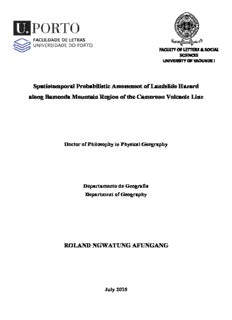
Spatiotemporal Probabilistic Assessment of Landslide Hazard along Bamenda Mountain Region of ... PDF
Preview Spatiotemporal Probabilistic Assessment of Landslide Hazard along Bamenda Mountain Region of ...
Spatiotemporal Probabilistic Assessment of Landslide Hazard along Bamenda Mountain Region of the Cameroon Volcanic Line Doctor of Philosophy in Physical Geography Departamento de Geografia Department of Geography ROLAND NGWATUNG AFUNGANG July 2015 Spatiotemporal Probabilistic Assessment of Landslide Hazard along Bamenda Mountain Region of the Cameroon Volcanic Line Thesis supervised by Professor Carlos Valdir de Meneses Bateira And co-supervised by Professor Roger Ngoufo Tese orientada pelo Professor Doutor Carlos Valdir de Meneses Bateira E co-orientada pelo Professor Roger Ngoufo This dissertation was done under the MUNDUS ACP II Project Sponsored by the European Commission and Coordinated by the University of Porto. Esta dissertação foi feita no âmbito do Projecto MUNDUS ACP II financiada pela Comissão Europeia e Coordenado pela Universidade do Porto July 2015 DEDICATION To My Father, Papa Ngwatung Clement Tamasang & My Late Mother, Mama Jenetta Masah Ngwatung Our life is in God's hand [...] “Destiny draws a black ball from the ballot-boxes of those living”. GUMBEL (1958) calculus of mortality probabilities July 2015 ACKNOWLEDGEMENTS This work is realised thanks to a number of people who through their literal, economic, physical and moral contributions, gave me the necessary means to go through. Many people more than I can count were instrumental directly or indirectly. I will as always, begin by thanking the Almighty God “Alfa & Amega” who has kept me alive and healthy and has given me the capacity to be able to do this work. Spatial thanks goes to the European Commission and the MUNDUS ACP PROJECT for their financial support and to the Coordination team including; Barbara Costa, Ana Paiva and Sara Martins who have supported me all through these years. I wish to express my sincere gratitude to Pr. Carlos Bateira who is my supervisor for his knowledge, experience and advice that has guided me all through this project. He laid the foundation of this work and spent extra time teaching me the techniques that I have used. His personal touch gave me the confidence that has pushed me to this level I also thank Pr. Roger Ngoufo who is my co-supervisor for providing the necessary support that I needed to fulfil the administrative requirements and the materials he gave for field work which has enrich the quality of this project. My gratitude goes to Pedro Goncalves who taught me many important techniques in GIS that I developed and applied during the studies. His assistance during the early days was crucial and enabled me adapt to the PhD programme at the University of Porto. My thanks also go to Pr. Antonio Gomes and Pr. José Teixeira for their guidance in developing the base materials that I needed for the research like the satellite image and the interpretation of the relief. I wish to acknowledge the contribution of Pr. Laura Soares and Pr. Antonio Costa for the assistance they gave me in ArcGIS. They taught me the Logistic regression model which I applied in the project. Many thanks to Dr Nkwemo Clement who gave me the thematic maps that I used at the beginning of this work My gratitude to Claude Rigobert Kameni, Barbara Costa, Ana Mato, Angela Leitao, Carla Augusto, Pr. Rio Fernandes and Pr. Tchawa Paul for their efforts in ensuring the signing of the co-supervision agreement between the University of Porto and University of Yaoundé. Spatial thanks go to Fr. Paulinus Abose and Ngwatung Calistus for their correction of the thesis and also to Manuel Teixeira and Djougang Agnes for their translation of the abstract Very special thanks to my wife, Ritreh Beatrice for taking care of our twin daughters, Larian and Lorinda during my long absence and to my family, Lawyer Teufack Prisca, Ngewung Calista, Ngwatung Norbert and Muma Gilbert for their moral support. i ii TABLE OF CONTENT LIST OF TABLES…………………………………………………………………………. .x LIST OF FIGURES………………………………………………………………………. xv ABSTRACT……………………………………………………………………………...xxiii RESUMO……………………………………………………………………………….. xxv RÉSUMÉ………………………………………………………………………………..xxvii ACRONYMES AND ABBREVIATIONS………………………………………………xxix INTRODUCTION ..................................................................................................................... 1 CHAPTER 1: THE STATE OF THE ARTS ........................................................................... 13 1.1. Natural Hazards ............................................................................................................. 13 1.2. Landslide hazard assessment ......................................................................................... 15 1.2.1. Landslides Probability concept ............................................................................... 18 1.2.2. Spatial Susceptibility concept ................................................................................. 19 1.2.2.1. Spatial analysis and modelling......................................................................... 20 1.3. Scale factor and models ......................................................................................... 22 1.3.1. Temporal probability concept ............................................................................. 24 1.4. Differences between landslide hazard and landslide risk .......................................... 26 1.5. Landslide monitoring .................................................................................................... 27 1.6. Landslide Inventory ....................................................................................................... 28 1.7. Slope Mechanisms and slope Instability ....................................................................... 29 1.7.1. Gravity .................................................................................................................... 29 1.7.2. Pore pressure........................................................................................................... 30 iii CHAPTER 2: PHYSIOGRAPHY AND ANTHROPOGENIC COMPONENTS OF THE STUDY AREA ........................................................................................................................ 35 2.1. Location of the study area ............................................................................................. 35 2.2. Physiography of the area ............................................................................................... 38 2.2.1. Relief and Morphology ........................................................................................... 38 2.2.1.1. The Volcanic Mountains .................................................................................. 40 2.2.1.2. Intermediate highlands ..................................................................................... 42 2.2.1.3. The Lowlands................................................................................................... 43 2.2.1.4. Eastern valleys ................................................................................................. 44 2.2.2. Lithology ................................................................................................................ 46 2.2.2.1. Volcanic rocks ................................................................................................. 49 2.2.2.2. Plutonic rocks................................................................................................... 52 2.2.2.3. Metamorphic rocks .......................................................................................... 53 2.2.2.4. Sedimentary rocks ............................................................................................ 54 2.2.3. Superficial formations ............................................................................................ 55 2.2.3.1. Degraded rocky outcrop and gravel ................................................................. 56 2.2.3.2. Talus deposit or Scree ...................................................................................... 56 2.2.3.3. Colluvium deposits .......................................................................................... 58 2.2.3.4. Laterite, Lateritic Clay and boulder clay materials .......................................... 59 2.2.3.5. Clay, volcanic ash, clay sand and silt materials ............................................... 60 2.2.3.6. Alluvial deposits .............................................................................................. 61 2.2.3.7. Anthrosols ........................................................................................................ 62 2.2.4. The drainage system ............................................................................................... 62 2.2.5. Vegetation ............................................................................................................... 64 2.2.6. Climatic condition .................................................................................................. 67 2.3. Land use dynamics .................................................................................................... 70 iv
Description: